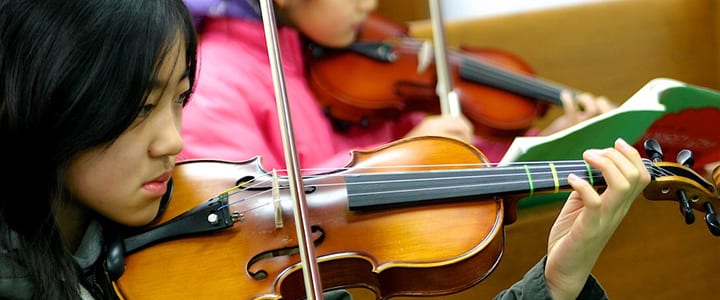
If you want to be a successful violinist, you need to learn proper technique, and that starts with your violin bow hold. Unfortunately, it’s easy to pick up bad habits. Austin, TX violin teacher Naomi S. is here to help; follow this guide to master your violin bow hold and improve your sound…
Proper violin bow hold is imperative to building a foundation as a budding violinist, but bow hold can be one of the most challenging aspects to master on the violin. Your bow hold affects your bow tone and your overall sound quality. A poor bow hold can cause a lot of roadblocks as you develop, so make sure to address the issue right away, and get really comfortable with your violin bow.
Most of my students look at me like I’m crazy when I show them how to hold a violin bow. In the beginning, it’s not always psychically possible to hold the bow correctly. When you hold your bow properly, you use a delicate set of muscles that you might not use in your everyday life, so it takes lots of time, repetition, and strength building to get your hand ready for the task.
Since you may be unsure of all the specifics of proper violin bow hold, I’m going to walk you through it, step by step, in this video tutorial.
Violin Bow Hold for Beginners
While the video will help you learn proper violin bow hold technique, I also have some helpful tips that you should keep in mind as you play. Here are 10 important things to look out for as you work to master your violin bow hold.
10 Ways to Improve Your Violin Bow Hold Technique
When you hold your violin bow, place your thumb on the little bump that’s under the stick and attached to the frog. Your thumb needs to remain bent at the middle joint, at all times, as all of your fingers on the bow hold curve inward and not outward.
This helpful trick goes for children as well as adults– if your thumb is flexed and curved, like a banana, you need to correct it and bend at the joint.
“Bananas” happen to almost all new violinists, especially for the first few months, but if you keep correcting yourself, your muscle memory will kick in and start to remember how the thumb should feel.
Your first finger, or pointer finger, should wrap around the grip. It’s usually a little black strip of leather or soft plastic for your first finger to grip onto. One common mistake is for students to reach up too far and place the first finger on the bow stick instead of the grip. Think of your finger as a hook that wraps around the grip and keeps your hand anchored and in place.
As you practice, make sure to watch out for these seven common violin mistakes!
Your middle finger and ring finger, often referred to as the “huggers,” don’t do a lot in the bow hold other than wrap or hug the frog. Make sure that you have your fingers bent at the middle joint and snug on the frog.
Many students place the tips of their fingers towards the top of the frog (near the bow stick), but it’s important to make sure the pads of your fingers are placed towards the bottom of the frog, so that you have full coverage over the frog and good balance for your entire hand.
Almost all bows come with a little white or light-colored dot on the bow. You may wonder if that dot has a purpose, but it can actually help you with your bow hold! The dot acts as a guide so that you can make sure your hand is positioned correctly. The pad of your ring finger should cover this dot.
Always check back while you’re playing to make sure your ring finger lines up with the dot.
As illustrated in the video above, the pinky or little finger’s job is to sit high on the stick and act as a weight to balance out the thumb. Like all of your fingers, in order to maintain good form and keep pressure off the fingers, the pinky should be curved at the middle joint.
A common issue for beginners is that the pinky wants to flex the other direction, which creates a “french fry” look. If your little finger looks like a french fry and is not curved under, make sure you correct it right away. Like “banana” thumbs, these french fries will pop in every chance they get when you’re first learning because your fingers haven’t built the strength they need to master this unusual hand position.
When you play a stringed instrument, it’s important to keep your fingernails on your left hand clipped and tidy, so that your fingers can go down easily on the strings. When you clip your fingers, however, make sure not to clip your thumb nail on your right hand (bow hand) too short. You can clip it, but it’s helpful not to cut the white part all the way off.
When you clip your nail too short, it can cause friction on your thumb against the bump where it rests. This can tug at your skin which makes it uncomfortable to play. If you leave a little sliver of the white part of your nail, it can help you grip the bump and act as a shield against any discomfort.
Remember, your bow hold is not a death grip! You’re not holding onto the bow stick for dear life, you’re holding onto it to create beautiful, emotive music.
Your violin bow hold should be delicate and graceful. Hold the bow tenderly, so that it might be possible for someone to grab the stick out of your hand.
Sometimes, during more intense sections in your songs, your grip may tighten, but always be mindful to loosen up when you can, so that your hand doesn’t get tired during the song.
It’s common for beginners’ bow hands to look like mountaintops. If your hand forms into the shape of a steep mountain with your knuckles popping up in the air, take time and care to make sure to bend each finger at the middle joint, and relax your hand down, into the position of a nice, rounded hill or plateau.
Similar to the mountaintop hand, your wrist may start to bend (too much) when learn how to hold your bow. As a beginner, your wrist should generally be in a straight or neutral pose. Eventually, as you draw the bow up towards the ceiling across your strings your wrist will bend and as you push the bow down towards the floor your wrist will flex. This sort of technique may take years to develop but it’s good to keep a relaxed and flexible wrist from the get go so that you can start to build good wrist foundation.
Eventually, as you draw the bow up towards the ceiling across your strings, your wrist will bend, and as you push the bow down towards the floor, your wrist will flex. This sort of technique may take years to develop but it’s good to keep a relaxed and flexible wrist from the get go so that you can start to build good wrist foundation.
This sort of technique may take years to develop, but it’s good to try to keep your wrist relaxed from the get go, so that you can build a solid foundation.
Last but not least, check in on your bow hold, constantly! Take breaks during your songs and glance back at your bow hand to make sure all your fingers are in place.
If something is off, stop everything and fix it right away. Sometimes, your hand may cramp up, and that’s a good time to take a break and shake it to let the muscles relax.
Eventually, you’ll become so aware of your bow hold that you’ll be able to correct things like “bananas” and “french fries” as you play, without stopping. In time, with enough practice and spot checking, these issues will go away.
Violin Bow Hold Exercises
Windshield Wipers
Here’s an excellent exercise to help develop the hand strength and flexibility you need to improve your violin bow hold.
Make sure to do this exercise every day for the first few months, until your bow hold becomes stable. You can start off by doing 10 repetitions, and then gradually increase to sets of 30.
It’s important not to overdo it when you first start learning, so pace yourself and take breaks in between your exercises.
Memorize the finger placement of the bow hold, remember the 10 pointers above, and use the Windshield Wiper exercise every day, and you’ll be well on your way to a flawless violin bow hold. Remember, proper violin bow hold technique leads to great sound quality and bow tone!
Have questions about your violin bow hold? Ask your teacher or let us know in the comments below!
 Post Author: Naomi Cherie S.
Post Author: Naomi Cherie S.Naomi teaches violin in Austin, TX. She is a classically trained violinist with over 20 years of experience and a diverse musical background. Learn more about Naomi Cherie S. here.
Photo courtesy Changjin Lee
Maile Proctor
![10 Sure-Fire Ways to Improve Your Violin Bow Hold [Video]](/_next/image?url=https%3A%2F%2Ftakelessons.com%2Fblog%2Fwp-content%2Fuploads%2F2016%2F02%2F10-ways-to-improve-your-violin-bow-hold.jpg&w=3840&q=75)










